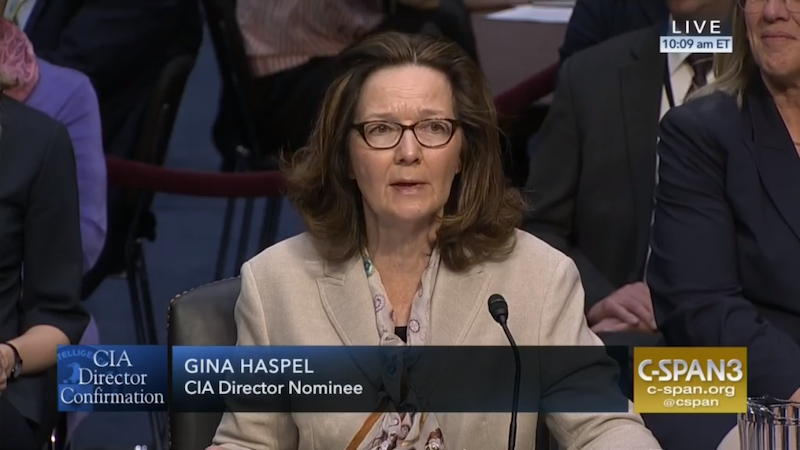In a move that Human Rights Watch described as “predictable and perverse,” the US Senate confirmed Gina Haspel as CIA Director on May 17th. Sitting in front of the Senate Intelligence Committee, Haspel was subject to a gruelling hearing from Democrats and Republican’s alike, with the spotlight on her past as CIA Station Chief. Running a previously classified Blacksite in Thailand, Haspel is credited with overseeing some of the most barbaric interrogation tactics employed during the Bush era. Responsible for the brutal treatment of Saudi nationals and Al Qaeda operatives Abu Zubaydah and Al-Nashiri, Haspel was fielded questions regarding her 33 years of experience, her level of transparency, and her moral character. In a 51-43 vote in favour of her nomination, Haspel was subsequently confirmed and will serve as the CIA’s first female Director since the organization’s inception in 1947.
Gina Haspel and the CIA
Little is known about Gina Haspel, but she comes with 33 years of insider knowledge and has earned the respect and support of numerous high-ranking officials from within the intelligence community. These include all of the past CIA directors, who commend Haspel’s service and commitment despite her record remaining largely classified. By contrast, Haspel’s same record has attracted criticism from those who would question her role during the CIA’s darkest years, a period characterized by extradition, mass incarceration, and institutionalized torture.
In the wake of 9/11, the CIA diligently sought out Al Qaeda operatives who they could link to the attacks, and subsequently proved to the Bush government the importance of intelligence in combating the war on terror. This led the organization to Abu Zubaydah, a known Al Qaeda officer working in Pakistan in 2002. Zubaydah was subsequently moved to the CIA’s first foreign detention site or “Blacksite,” officially referred to as DETENTION SITE GREEN. The location of this site was only recently declassified, after the Senate Intelligence Report on Torture was released in 2014. Recent findings suggest that the site was in Thailand, where Haspel operated as Station Chief. During his incarceration, Zubaydah was compliant with FBI facilitated requests for information. Revealing to officials that an individual named “Mukhtar” was the Al Qaeda leader responsible for the 9/11 attacks, Zubaydah identified Khalid Sheikh Mohammed (KSM) as being the mastermind. Zubaydah also provided representatives with information on Al Qaeda activities, plans, capabilities, and further relationships, in addition to information on it’s leadership structure, including personalities, decision-making processes, and tactics. Despite the FBI having gleaned valuable information from the detainee, CIA officials claimed that he was offering up “throw away information,” and decided to engage in more aggressive methods of gleaning data.
While the information provided was clearly an asset according to FBI operatives, Zubaydah’s inability to provide direct information regarding the next attack on the United States served as the means for the CIA to label him as “uncooperative.” The subsequent decision was that “enhanced interrogation techniques” would need to be utilized. Under the supervision of Haspel, Zubaydah was subject to several techniques from the US military’s SERE (Survival, Evasion, Resistance, and Escape) school. These included the attention grasp, walling, the facial hold, the facial slap, cramped confinement, wall standing, stress positions, sleep deprivation, complete isolation, waterboarding, and other programs designed to dehumanize Zubaydah. All of the tactics employed at DETENTION SITE GREEN were video recorded, but Haspel and her supervisors subsequently destroyed the tapes. Jose Rodriguez, former director of the National Clandestine Service during Haspel’s rotation in Thailand, justified the destruction of the video evidence based on the belief that the tapes “would make the CIA look bad,” and would compromise the security of intelligence operatives.
Does Torture Work?
During Haspel’s senate hearing, the primary focus was on her moral character, particularly as it relates to her history at the CIA. Kamala Harris, Senator from California, repeatedly asked Haspel if she saw torture as a moral and effective method of gathering data. The newly appointed director evaded all questions regarding morality, but did claim that valuable data was gathered through her methods of interrogation. Haspel asserted several times that she would never compromise American positions on torture as they were newly outlined in the US legal system. This includes a new prohibition on torture, which Haspel promises to never attempt to subvert during her time as Director. Despite her convictions, 48 percent of Americans see torture as an acceptable and effective means of obtaining information under certain circumstances. Many experts dispute this issue, stating that torture is neither effective nor acceptable.
The North Carolina Commission of Inquiry on Torture (NCCIT) is a 501(c)3 organization set up to investigate and inform the public regarding America’s torture program that was used from 2001 to 2009. Part of this inquiry included testimonies from various experts and relevant individuals, some of whom experienced the CIA’s programs personally. Mohamedou Ould Slahi, a Mauritanian citizen who was taken from his home in 2001, experienced the worst of the program during his 8-month detainment in Jordan, and subsequent years of abuse at Guantanamo. Prior to his release in 2016, Slahi was subject to torture tactics that included extreme cold and noise, extended sleeplessness, forced standing, threats against his family, and sexual humiliation. Accused of being an Al Qaeda sympathizer, Slahi was unable to give the CIA relevant information, despite being subject to abuse for several years. In separate testimony, Alberto Mora, former General Counsel of the Navy and staunch opponent to the coercive tactics utilized at Guantanamo, reasserted how the damaging effects of torture greatly outweigh the benefits. Mora described how the advice presented to the CIA by their legal team was inaccurate, and that torture has been more strategically damaging to US interests. The former Counsel described how the tactics are not only devastating to American values and integrity, but are also counterproductive to US foreign policy efforts, particularly with respect to upholding and respecting international law and bilateral relations. Mora went further to cite America’s use of torture as a serious impediment to national security, effectively damaging alliances and making American soldiers targets in Iraq and Afghanistan. Agreeing with his testimony, Steve Kleinman, a military intelligence officer and recognized expert in the field of human intelligence and strategic interrogation, cites how torture is also known for failing to illicit the best type of memory and accurate information. Kleinman cited the famous and successful German interrogator Hanns Sharff, who utilized empathy and common ground to extract useful information from detainees.
Overall, experts agree that torture is not the most effective method of obtaining information. The use of enhanced interrogation under the Bush era is widely considered one of the darkest periods in American politics and society. Intelligence operatives and politicians alike seemed willing to compromise their morals in the name of national security. With the successful nomination of Gina Haspel in conjunction with the US president’s support of enhanced interrogation, questions remain regarding the status of the program. Will Haspel maintain her newfound morality regarding torture? Or will she return to her old ways at the request of Donald Trump? Who’s moral compass will she use to navigate in her new role?
Gina Haspel Confirmation (2018), by C-SPAN via Wikimedia Commons. Public Domain.
Disclaimer: Any views or opinions expressed in articles are solely those of the
authors and do not necessarily represent the views of the NATO Association of
Canada.




